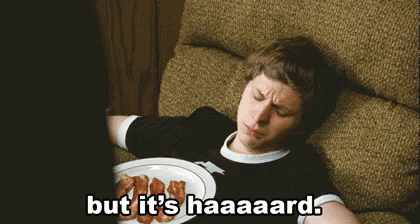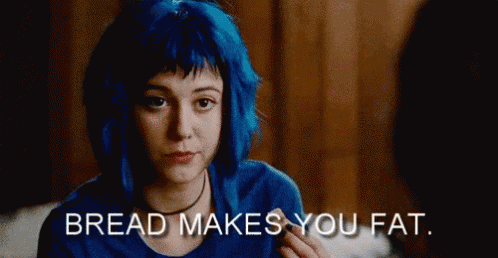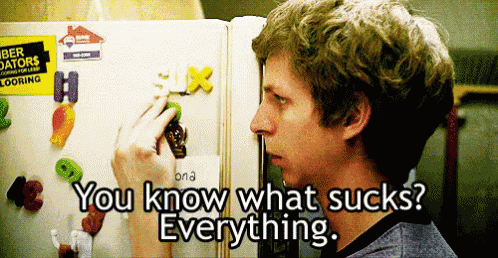Never Weight: A Year of Success (or a Tale of Water and Sadness)
July 5th, 2019 by PotatoMy first few “never weight†updates were not very successful. It was this time last year when I finally buckled down and started to get successful. Now down ~40 lbs, I was talking about my success today and figured it would be worth a blog post about how I made it work. I’m not about to go write a self-help book, and I’m far from the fittest, healthiest guy, but I did make some progress and hopefully some of the things that helped me will be translatable.
First, the basics: eat less, move more. Move more, eat less. Calories out > calories in.
It is just that simple. But simple is not the same as easy. And it is not easy. I tried many times over many years to kind of half-ass my way to better health and never managed to lose more than 10 lbs or stick to it for longer than two seasons. It’s hard to create new habits, and to break old pathways that have had a lifetime of reinforcement in your cerebellum and autonomic nervous systems.
So it’s ok to acknowledge that it’s hard. It will be hard, and it’s hardest at the beginning.
There are lots of ways to try to approach eat less, move more, specialized diets and approaches, and I find a lot are over-hyped. They can help in various ways, but at the end of the day there may be mumbo-jumbo about insulin control or protein metabolism or whatever that they focus on when really they’re mechanisms to enable calories out > calories in.
For me, I needed a “Holy Shit†moment. I actually had a few: the first when I hit my “never weight†in the first place and decided that I needed to re-prioritize my life and stop sacrificing health at the altar of blogging/work/etc. That was near the end of 2016, so it became a new year’s resolution. But while I made some improvements – I started tracking steps to move more, tried swapping candy for almonds & cereal at my desk, I just didn’t make great progress. The second “holy shit moment†came last summer – I had put in a commitment mechanism and still failed. My cholesterol test came in higher than is healthy. My dad got cancer. A clever SMBC comic made me realize I can’t really take short-cuts. I finally started doing the things I knew I had to be doing all along.
On to my tips and reflections:
Most important: tracking what you eat (and your exercise).

Yes, it’s hard to nail the landing with that one. It takes time, it’s a pain to do, etc. I found FitBit really helpful (but other apps work similarly, e.g. MyFitnessPal):
- It’s on my phone, and my phone is nearly always near me when I’m eating.
- It tracks my exercise and gives me a budget, so I get instant feedback/permission (unlike tracking on paper) – I can pretend it’s a magic 8-ball and say “hey FitBit, can I eat this?†and it would say “yes, but then all you’ll get for dinner is water and sadness†and I could make a more informed decision, instantly.
- I had a hard-and-fast rule that I had a 2000 calorie line of credit – enough that sometimes if I wanted a heavier lunch and lighter dinner I could have a bit of flexibility to make it work, but mostly I only ate what FitBit said I could. Cash only, no credit. If I wanted any more than that, I had to earn it through exercise first (and some days I did earn over 2500 calories, but I did the curling/biking/stairs first).
- The app made tracking easy because I could save foods I eat often, and it had a database of many common foods (so instead of having to calculate every time, I could just type in “french fries, large†and get a decent estimate (and sometimes even the details for the exact brand of food I was eating).
- It provides a simple colour-coded bar chart of energy out and energy in, and all I have to do for success is keep the bars green or teal.
I got cute about checking it. If a coworker brought timbits back from a meeting, I’d pull out my phone, open it up and go “thanks, but FitBit says no.â€
Another important point was to keep in mind that people are bad at estimating. I started eating a lot of single-serve packs of things (esp. almonds) so I’d know how much was in there. I started using my food scale, and everything was put on a plate or in a bowl so I could be consistent in how much I took and keep my estimates close (and I started using the tiny baby plates and bowls to make things look like bigger portions). No eating right out of a bag. After doing it a few times I got decent at estimating how much I poured into a bowl, and would stop using the scale every time – but I still go back every month or so and check myself so I don’t get portion creep.
Break habits – break eating – bright-line rules
There’s a lot of automaticity in our daily lives, especially when it comes to eating (unconscious eating). That has to be fixed, along with emotional eating. In part, I had to break eating to stop the old habits.
Looking back, a reader (hi Joe!) had told it to me straight up in the comments section back in 2017, but I had to learn it the hard way: a drastic change can work better than trying to be incrementalist about it. Kind of like the spending bans for the debt bloggers.
So I had to break how I ate to make it more mindful. Part of that was through checking with FitBit before I ate anything. Whenever I was eating at my desk or the couch (not so much an issue at home at the kitchen table at meal time) I would ask “do I want to eat this because I’m hungry, or because I’m bored/stressed/nibbly/etc.?†If I was just wanting to move my mouth for non-hunger reasons, I’d chew some sugar-free gum. If I was actually hungry, I could then check FitBit for a meal/snack. Or (particularly the first two weeks), I’d text a friend and whine (thanks Netbug!).
I also had to pause now and then to see if I wanted to eat more. I got a lot of small 50-200 calorie portions of stuff, like single-serve packs of almonds, Welches fruit snack candies, protein bars, etc. And opening each one gave me a point to stop and reflect: did I want this? Was I actually still hungry? Would the second (or third) portion really do anything for me that the first or second hadn’t? Maybe even if I still felt hungry I could wait a half hour before the next serving? I also started doing something that sounds totally crazy but kind of works: if I want to eat for emotional reasons, I get up from my desk and go down and back up a flight of stairs. It adds activity and takes my mind off food (I did not believe people who said more exercise somehow makes you less hungry, and it still seems crazy).
At first I needed a few hard-and-fast rules: no candy, no doughnuts (not even timbits), no chips.

Then I gradually re-introduced treats in more appropriate proportions and frequencies and (so far) have been mostly successful with keeping things much more balanced. But particularly when trying to break old habits, I found it handy to have rigidly defined black-and-white areas (and it was only once I had tracking with an app to lean on as my hard-and-fast way to control snacking that I could be trusted with snacks).
Another thing I used was a weak form of intermittent fasting: for 11-12 hrs every day, there was no eating. No breakfast before 11am, no snacking after midnight. I was a mogwai, and I didn’t want to turn into a gremlin. Yes, I found a way (more than once) to use that analogy out loud. I found a lot of over-hyping on intermittent fasting out on the web, but it is helpful, and it can make it a lot easier to be hungry (my body quickly got used to the idea of no breakfast – I was already prone to skipping it), and make it easier to make the calories out > calories in thing work. Plus it was a simple, bright-line, hard-and-fast rule that eliminated late-night snacking, which was one of my weaknesses.
Priorities, permission, and mindfulness
Life is full of conflicting priorities, and it’s very hard to optimize everything at once. So one important change in mindset was giving myself permission to make my health more of a priority. I increased our grocery bill buying my almonds in single-serve packs (roughly 4X the price-per-weight of buying a big jar, but the fancy ones are tastier & more satisfying, while being more amenable to mindful eating), and a bunch of other similar moves. I buy a lot more single-serve/treat size/etc. things and don’t just buy the best value or things in bulk. I can’t optimize the budget/retirement savings at the same time as my health.
I also try to focus on what I’m eating and enjoy it (though I am still definitely a wolfer). I recognize that ice cream is delicious, but a double scoop is not twice as delicious/satisfying as a kiddie cone. I gave myself permission to eat half of something and throw the rest away if it’s not worth the calories.
I also (mostly) found the time and budget to curl more (though I need to put myself into more summer exercise commitments – for now I’m trying to take the stairs up to my 5th floor office at least once a day).
Buddy/mentor system
Particularly the first two weeks, I was bugging friends a lot (mostly Netbug). I whined and complained and vented. The world was unfair – for years I had considered a 10-pack of timbits to be a nice mid-afternoon snack, and now was being told it was more than most of my meals. Subway was pulling a bait-and-switch with it’s large-print calorie counts – no one is ordering a veggie sandwich sans cheese and dressing, and adding those nearly doubled the calories of the final product. I wanted to eat but I wasn’t hungry and it wasn’t faaaaaaaair and is being fat so bad, really?
And I wasn’t legitimately hungry through most of it – I was just upset that I couldn’t have all the yummy things, and needed to vent those feelings. I think having someone who’s either going through it with you, or who has been there can be helpful.

Commitment mechanism
My initial commitment mechanism failed, but I still think it was a helpful approach to keep me on-mission.
The bathroom scale is a dirty, dirty liar; trust the process
I recognized that there’s a lot of noise in daily weight measurements. I mostly only weighed and tracked myself weekly, and the trendline in FitBit was pretty good at that resolution. I only reported here quarterly. Your weight can fluctuate by several pounds day-to-day, especially if you’re at all inconsistent about what you’re wearing when you do it or the time of day you do it.
My suggestion based on what I did is to not weigh yourself that often – just like with checking your stock portfolio too often, you’re more likely to be happy if you only check when there’s a decent chance of the signal outshining the noise. So biweekly/monthly, maybe as often as weekly.
However, I was listening to a podcast from Dan Ariely and he suggested a way to redesign the bathroom scale to send a number to an app that just shows you your smoothed trend, but not any day’s (noisy) result. And the point he was making is that stepping on the scale every morning is a good reinforcing behaviour – you can step on there and say (out loud or implicitly) that your weight and your health is important to you so you’re going to live today in a way that reflects that. But that can be sabotaged by seeing your weight randomly fluctuate up despite being good the day before.
Rather than get a fancy technology scale (that might not even exist on the market yet), my suggestion is to tape over the display with a helpful message. I suggest “TRUST THE PROCESSâ€. Step on it every day, say your affirmation, look at the message that you should trust the process. Then once or twice a month peel the tape off and check your progress.
Good luck!
Hopefully some big-bang behaviour changes and bunch of hacks will help you. I’m far from a guru, and failed a lot on the way, and it’s only been a year of being successful (and I’m still struggling to stick that landing). But I thought it was a good exercise to stop and reflect on what worked for me. (and no, there have not been more than a few “nights of water and sadness” but I like the quip :)



 Questrade: use QPass 356624159378948
Questrade: use QPass 356624159378948 Passiv is a tool that can connect to your Questrade account and make it easier to track and rebalance your portfolio, including the ability to make one-click trades.
Passiv is a tool that can connect to your Questrade account and make it easier to track and rebalance your portfolio, including the ability to make one-click trades.